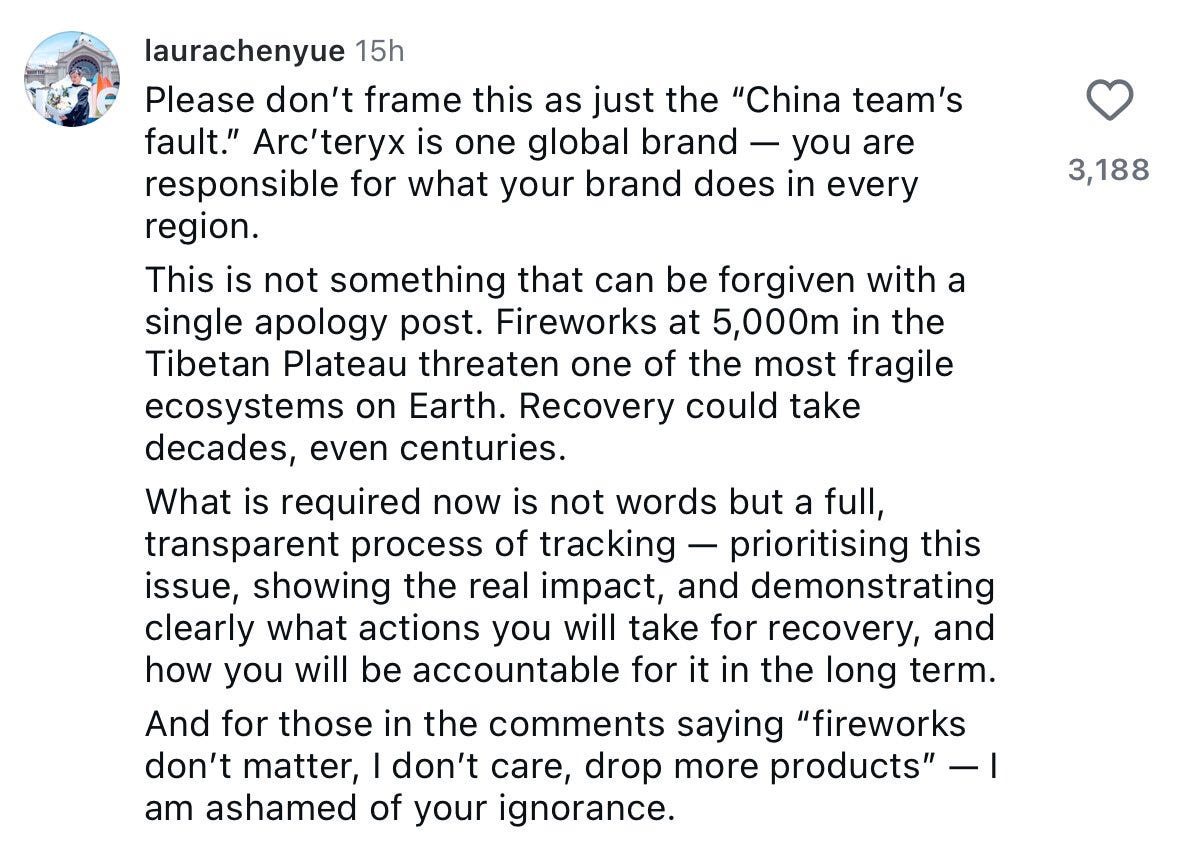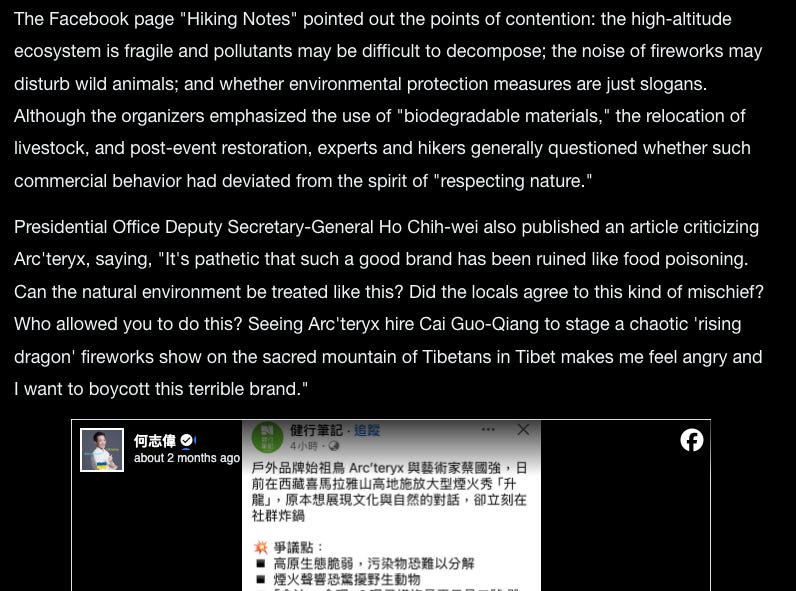$AS Amer Sports Arc’teryx Hit by 600M-View Boycott in China Over Controversial Tibet Fireworks Show
Outrage over alleged environmental destruction drives one of the largest social-media spikes in Arc’teryx history
A boycott of Arc’teryx in China erupted in September 2025 after the brand sponsored a controversial fireworks display in Tibet called Rising Dragon. The display was widely criticized as environmentally destructive and fundamentally at odds with Arc’teryx’s identity as a nature-first outdoor brand, triggering an immediate and unprecedented backlash across Chinese social platforms.
The controversy has evolved from a short-term reputational crisis into a potential structural risk to Arc’teryx’s long-term growth in China, one of the most important markets for both Arc’teryx and its parent company Anta’s premium-brand portfolio.
Arc’teryx issued an apology and announced an environmental investigation, but public anger only intensified. Chinese media outlets have described the incident as “permanently damaging” to consumer perception, and the company’s crisis response, initial silence, a delayed statement, and confusion over internal accountability, fueled further criticism. Anta’s complete silence throughout the controversy became another focal point of public frustration.
Environmental groups and regional officials emphasized the fragility of the Tibetan plateau, noting that even minor human disturbance can have lasting consequences. In this context, video of the large-scale detonation struck a nerve with outdoor enthusiasts, conservationists, and the broader public.
Social discussion surged at record levels. Mentions of Arc’teryx on WeChat spiked to nearly 600 million, representing one of the largest single-week increases in brand conversation ever recorded on Chinese social media. Comment threads and hashtags consistently expressed anger, disappointment, and accusations of greenwashing.
“As someone who once spent several months deep in the Tibetan region of Ngari as an outdoor enthusiast, let me explain why I feel so heartbroken.
On the snowy plateau, it is incredibly difficult for animals and plants to survive. Sometimes you can walk across huge stretches of barren land and only occasionally see a bit of moss or a tiny plant. In that thin-oxygen environment, every small life form that persists is enough to move you to tears.
All I left behind were footprints. I took nothing else, only respect and gratitude. I never expected that Cai Guoqiang and Haya Bird would actually blow up a mountain just for their art project and commercial promotion! Watching the massive explosion in the video felt like witnessing destruction firsthand.
Don’t tell me that blasting is approved for environmental purposes, and don’t use “relocating wildlife or restoring plants” as excuses. Anyone with even the slightest conscience would never do something so immoral! Snow hares, snow finches, and so many protected rare plants—just one explosion destroys an entire area. How are you going to restore that?
This is utterly unacceptable. These two names are permanently on my personal blacklist.”
“The second mistake was Arc’teryx and Anta’s silence.
After the incident, the brand did not respond immediately. Two days later, it issued an apology letter, but that letter triggered new controversy over “double standards” and “blaming the China team.” After that, Arc’teryx fell back into silence. Anta, meanwhile, never made any statement from beginning to end.
Only about a month later did the Shigatse government release an official notice, concluding that Arc’teryx must bear ecological compensation. After this announcement, Arc’teryx finally said the General Manager of Greater China had stepped down.
Given the backlash so far, restoring the brand’s reputation and rebuilding user trust will not be easy.”
Conclusion
The fallout from the Rising Dragon campaign represents more than a PR misstep, it exposes a deeper vulnerability in Arc’teryx’s China strategy. China has been one of the brand’s fastest-growing and highest-margin regions, vital to Anta’s premium-outdoor segment and a major contributor to Arc’teryx’s global expansion story. When a core consumer base perceives a brand as violating the very values it claims to embody, respect for nature, minimal impact, authenticity, the damage compounds beyond a single news cycle.
The scale of the backlash, the record-level social discussion, and the sentiment shift across Chinese digital ecosystems point toward a risk that is not merely episodic but structural. Brand trust, especially in the outdoor category, is slow to rebuild once broken. With Arc’teryx positioned as a status symbol for China’s urban middle class and a technical badge of honor for the country’s growing outdoor-sports community, erosion of credibility threatens both ends of its demand curve.
The forced resignation of the Greater China General Manager and the ecological compensation ruling signal institutional recognition of the severity of the crisis, but they do not guarantee recovery. If Arc’teryx cannot convincingly demonstrate environmental accountability and regain cultural legitimacy within China’s highly reactive social media environment, the controversy could place a long-lasting cap on the brand’s growth potential in one of its most strategically important markets.
The broader implication is clear: the Tibet incident may mark a turning point in Arc’teryx’s China narrative, transforming a fast-expanding success story into a structurally constrained segment unless the brand can rebuild trust at scale and re-align itself with the values that made it aspirational in the first place.






